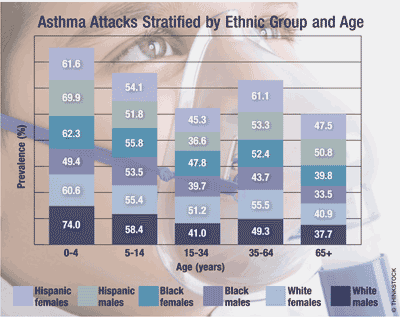US Pharm. 2013;38(7):22.
Among noninstitutionalized adults, 18.9 million (8.2%, or 1 in 12) experienced asthma in 2009, as did 7.1 million (9.5%, or 1 in 11) children. More than half (52.2%) of children with asthma were diagnosed within the past 5 years. Patients with asthma more often sought professional assistance at a physician’s office (14.2 million) than at an emergency department (1.8 million) or hospital outpatient clinic (1.3 million). Routine visits to a physician were made by nearly three-quarters of children with asthma (72.8%). The average length of hospital stay for asthma treatment was 3.6 days, and asthma claimed nine lives each day. The CDC estimated that asthma cost $56 billion per year, and the average annual cost of care for a child with asthma was $1,039.

Asthma’s Effects on Quality of Life: Each year, 1 in 2 children with asthma missed at least one day of school because of asthma, and 1 in 3 adults missed at least one workday. Limitation of physical activity was reported by 3 in 5 patients (both children and adults). Children experienced more asthma attacks compared with their adult counterparts. Difficulty affording asthma medications was a factor for 1 in 4 black and 1 in 5 Hispanic children. Black adults were hospitalized for asthma more often compared with white adults (28.5% vs. 9.5%).
Asthma Attacks: The number of patients experiencing an asthma attack was relatively stable (varying from 3.9% to 4.3%) from 2001 to 2003, but then increased at the rate of 2.6% annually, from 11 million in 2003 to 13.9 million in 2010. Asthma attacks occurred in a greater percentage of children (4.3 million; 5.5%) versus adults (9.6 million; 4.9%), and they were more common in females (8.5 million) than in males (5.4 million). Non-Hispanic patients (11.9 million) had the most asthma attacks, followed by white patients (10.4 million); Hispanic patients (2 million) had the fewest episodes. Between 2003 and 2010, however, white patients saw an increase in asthma attacks at a rate of 1.6% per annum.
Asthma Management: Asthma-management plans resulted in a reduced prevalence of attacks in asthma patients, from 55.8% in 2001 to 51.9% in 2010 (at a rate of 1% per year). Among children, a 5% decrease (from 61.7% to 58.3%) in asthma attacks was reported during the same period. Among children who attended school or day care, 40.4% had access to an asthma-management plan at school or day care. Environmental changes were advised by a health care practitioner for 42.4% of children with asthma.
To comment on this article, contact rdavidson@uspharmacist.com.






